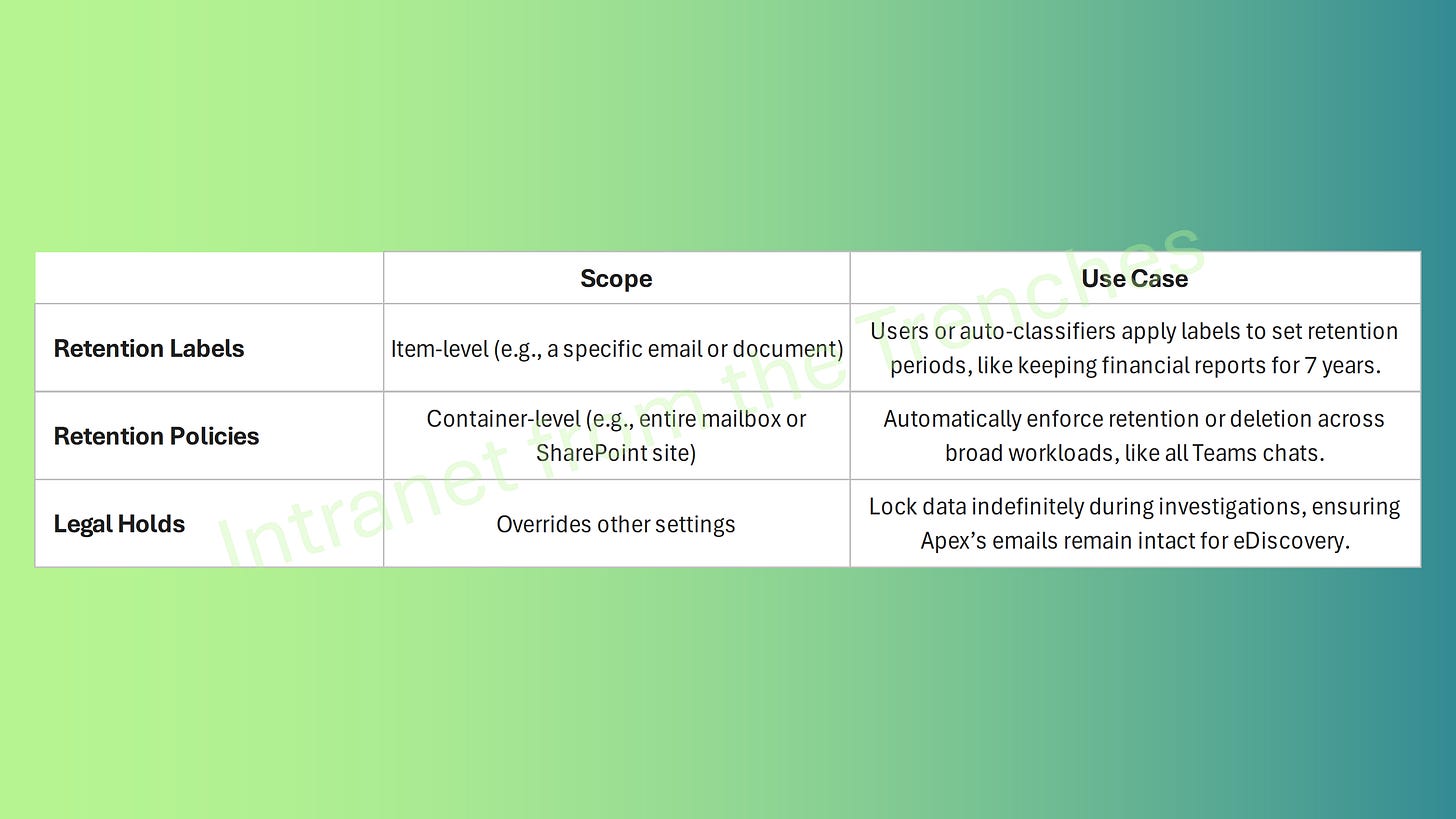Mastering Retention Policies in Microsoft Purview
It’s a typical morning at Apex Finance, a mid-sized investment firm, when an email from regulators flips your world upside down—an insider trading probe demands every email, chat, and document be preserved, no exceptions. One misstep could mean fines that cripple the company. If the stress of a compliance audit hits close to home, this guide is your lifeline. We’ll unpack retention policies in Microsoft Purview, transforming a potential nightmare into a manageable, even empowering, process.
Why read on? Retention policies aren’t just tech jargon—they’re tools that can protect your organization during legal challenges, streamline data management, and keep your team focused without fear of accidental deletes. Drawing from Apex’s scenario, inspired by real-world compliance struggles, we’ll cover the basics, evolution, key components, practical applications, and steps to get started. By the end of this series, you’ll see Purview as a secret weapon against data chaos. Ready to dive into the first step and take control?
Why Retention Policies Matter for IT Admins and Compliance Officers
Retention policies in Microsoft Purview are your data’s protectors, automatically managing what to keep, for how long, and when to delete across your organization’s tools. They ensure compliance with legal requirements, like those Apex faces, without manual effort. Think of them as set-it-and-forget-it rules that prevent permanent data loss, crucial for eDiscovery (a tool for legal data searches) during investigations.
Here’s why they’re a game-changer:
Compliance: Meet regulations like GDPR, SOX, or HIPAA, which demand specific data retention periods.
Cost Savings: Reduce storage costs by deleting outdated, irrelevant data.
Efficiency: Simplify audits, as admins at a financial firm reported cutting prep time from 40 hours to 20 hours using Purview.
Data Protection: Retain critical content in place—emails in Exchange Online stay recoverable, SharePoint and OneDrive files go to a hidden Preservation Hold library, and Teams chats are stored in special Exchange folders.
For IT admins and compliance officers new to Purview, these policies mean confidently telling your boss, “We’ve got this covered”. This article kicks off our series by laying the foundation for mastering Purview’s retention capabilities.
From MRM to Purview’s Unified Power
To appreciate Purview’s strength, let’s look at its roots. Messaging Records Management (MRM), the old-school tool for Exchange Online, used retention tags to manage email lifecycles, like archiving or deleting after a set period. It was effective for emails but limited, like using a hammer for every task—focused on deletion and unable to handle SharePoint or Teams.
Microsoft Purview changes the game. Unlike MRM’s Exchange-only focus, Purview unifies retention across emails, files, chats, and more. It offers flexible options—retain-only, delete-only, or both—and integrates eDiscovery holds to preserve data during legal probes, like Apex’s. Transitioning from MRM? Assess your tags, map them to Purview policies, and test on a small scale to avoid conflicts. One admin I know botched the migration and faced weeks of cleanup; done right, it’s like upgrading from a rusty bike to a sleek electric one, making compliance smoother and faster.
Labels, Policies, and Holds Explained
Now that we’ve seen Purview’s evolution, let’s explore its tools: retention labels, policies, and holds. Understanding these components helps Apex—and you—build a robust compliance strategy.
Advanced features add precision:
Adaptive Scopes: Dynamically target content using queries, such as retaining emails from “department:executives” longer during audits. For example, a query like “from:ceo@apexfinance.com” ensures only specific emails are targeted.
Event-Based Triggers: Activate retention after specific events, like locking an employee’s OneDrive files when their account is deactivated, ideal for HR compliance. For instance, setting a trigger for “user account disabled” automates retention for departing staff.
To avoid surprises, start with policies for broad coverage, layer labels for precision, and test configurations. Misconfigured policies can lead to over-retention or data loss, so pilot them on a small group first.
Practical Steps for Implementing Retention Policies
Ready to put Purview to work? Here’s a step-by-step guide to set up retention policies effectively, ensuring Apex—or your organization—stays compliant and efficient:
Assess Your Needs: Identify regulatory requirements (e.g., 7 years for SOX financial records) and key workloads (Exchange, Teams, SharePoint). For Apex, this means prioritizing executive emails and financial documents.
Start with Policies: Create a broad retention policy in Purview’s admin center. For example, set a 5-year retention for all Teams chats to cover general compliance, testing on a single team first.
Layer Labels: Use labels for specific needs, like auto-applying “SOX Compliance” labels to SharePoint documents with keywords like “financial statement.” Train users to apply labels manually if needed.
Test and Monitor: Run a pilot on a small group, such as one department’s mailbox, to catch issues like over-retention. Use Purview’s reports to track policy performance.
Train Your Team: Educate users on labeling and compliance to reduce resistance. A quick 30-minute training session can prevent weeks of cleanup.
Review Regularly: Schedule quarterly reviews in the admin center to adjust policies as regulations or business needs change.
Pro Tip: Use Purview’s simulation mode to preview policy impacts without applying them, saving you from costly mistakes.
These steps empower you to roll out policies confidently, turning compliance from a headache into a streamlined process.
Real-World Scenarios
Let’s make this concrete with Apex’s scenario, showing how Purview tackles compliance challenges across workloads.
Exchange Online (Emails): Apex’s probe requires indefinite holds on executive emails. A Purview policy retains all emails from their creation date, with MRM tags migrated to avoid conflicts. Even if deleted, emails remain recoverable via eDiscovery.
Teams (Chats): To trace decision-making, Apex applies a retain-only policy to Teams chats. Messages are copied to hidden Exchange folders, searchable during investigations, even if users delete them.
SharePoint (Financial Docs): For SOX compliance, Apex uses auto-classified labels based on keywords (e.g., “financial statement”) to retain documents for 7 years. If tampered with, copies are preserved in the Preservation Hold library.
OneDrive (Employee Files): When an employee leaves, an event-based trigger locks their OneDrive files, ensuring compliance without disrupting workflows.
These setups aren’t hypotheticals. Consider tax forms retained for audits or press materials deleted to avoid litigation risks—all while cutting storage costs.
Conclusion
From Apex’s regulatory panic to your potential triumph, Microsoft Purview transforms compliance chaos into a structured superpower. Evolving from MRM’s limitations, Purview unifies retention across workloads, protects data during legal probes, and streamlines audits. As someone who’s wrestled with these tools (and maybe spilled coffee over a config or two), I can say mastering Purview not only shields you from legal risks but frees up time for the fun parts of tech. This first article in our five-part series lays the groundwork—stay tuned for deeper insights on advanced configurations, migrations, and more.
Ready to turn your compliance strategy into a strength? Start with a pilot policy in Purview’s admin center, test on a small group, and watch data chaos become a thing of the past. For Apex, Purview turned a nightmare into a manageable process—and it can do the same for you
References
Learn about retention policies & labels to retain or delete: https://learn.microsoft.com/en-us/purview/retention
Learn about retention for SharePoint and OneDrive: https://learn.microsoft.com/en-us/purview/retention-policies-sharepoint
Learn about retention for Microsoft Teams: https://learn.microsoft.com/en-us/purview/retention-policies-teams




